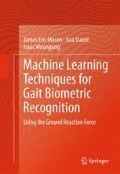Abstract
The design of a gait-based biometric system is highly dependent on the aspect of gait being studied and may be limited by the tools available for study. The research presented in the previous chapter has suggested that the ground reaction force , measured using either a WS or FS approach, may lead to better results than might be achieved using a more conventional MV approach. Consequently, for the purpose of the analysis provided in this book, we have chosen to study GRF-based gait recognition, and for the remainder of the book, we will be performing the analysis on the GRF data acquired via a floor-mounted force plate (an FS approach ). The GRF is typically represented as one or more discrete-time signals measuring the force exerted by the ground back on the foot at varying points in the footstep. This signal representation of the GRF is advantageous because it opens the gait biometric for study using well-established and leading edge analysis techniques, which have often previously catered to the examination of similar problems in alternate domains. In this chapter, we begin by exploring the GRF in greater detail and proceed to describe the varying analysis techniques used in previous GRF recognition studies. In doing so, we identify several key research gaps, which will be addressed via novel research presented in the chapters that follow.
Access this chapter
Tax calculation will be finalised at checkout
Purchases are for personal use only
References
Addlesee, Michael D., Alan Jones, Finnbar Livesey, and Ferdinando Samaria. 1997. The ORL active floor (sensor system). IEEE Personal Communications 4(5): 35–41.
Bouchard, Guillaume, and Bill Triggs. 2004. The trade-off between generative and discriminative classifiers. In International Conference on Computational Statistics, 721–728. Prague.
Boulgouris, Nikolaos V., Konstantinos N. Plataniotis, and Dimitrios Hatzinakos. 2006. Gait recognition using linear time normalization. Pattern Recognition 39(5): 969–979.
Cattin, Philippe C. 2002. Biometric authentication system using human gait, Ph.D. Thesis 2002, Zurich, Switzerland: Swiss Federal Institute of Technology.
Kistler force plate formulae. [Online]. http://isbweb.org/software/movanal/vaughan/kistler.pdf.
Mostayed, Ahmed, Sikyung Kim, Mohammad Mynuddin Gani Mazumder, and Se Jin Park. 2008. Foot step based person identification using histogram similarity and wavelet decomposition. In International Conference on Information Security and Assurance, 307–311, Busan.
Moustakidis, Serafeim P., John B. Theocharis, and Giannis Giakas. 2008. Subject recognition based on ground reaction force measurements of gait signals. IEEE Transactions on Systems, Man, and Cybernetics-Part B: Cybernetics 38(6): 1476–1485.
Ng, Andrew Y., and Michael I. Jordan. 2001. On discriminative vs. generative classifiers: A comparison of logistic regression and naive Bayes. In Advances in Neural Information Processing Systems 14 (NIPS 2001), 841–848. Vancouver.
Orr, Robert J, and Gregory D. Abowd. 2000. The smart floor: A mechanism for natural user identification and tracking. In CHI ‘00 Conference on Human Factors in Computer Systems, 275–276, The Hague.
Plantiga. [Online]. http://www.plantiga.com.
Rodríguez, Rubén Vera, Nicholas W. D. Evans, Richard P. Lewis, Benoit Fauve, and John S. D. Mason. 2007. An experimental study on the feasibility of footsteps as a biometric. In 15th European signal processing conference (EUSIPCO 2007), 748–752, Poznan.
Rodríguez, Rubén Vera, John S. D. Mason, and Nicholas W. D. Evans. 2008. Footstep recognition for a smart home environment. International Journal of Smart Home 2(2): 95–110.
Suutala, Jaakko, and Juha Röning. 2008. Methods for person identification on a pressure-sensitive floor: Experiments with multiple classifiers and reject option. Information Fusion Journal, Special Issue on Applications of Ensemble Methods 9 9(1): 21–40.
Taylor, Amanda J., Hylton B. Menz, and Anne-Maree Keenan. 2004. The influence of walking speed on plantar pressure measurements using the two-step gait initiation protocol. The Foot 14(1): 49–55.
Author information
Authors and Affiliations
Corresponding author
Rights and permissions
Copyright information
© 2016 Springer International Publishing Switzerland
About this chapter
Cite this chapter
Mason, J.E., Traoré, I., Woungang, I. (2016). Gait Biometric Recognition Using the Footstep Ground Reaction Force. In: Machine Learning Techniques for Gait Biometric Recognition. Springer, Cham. https://doi.org/10.1007/978-3-319-29088-1_3
Download citation
DOI: https://doi.org/10.1007/978-3-319-29088-1_3
Published:
Publisher Name: Springer, Cham
Print ISBN: 978-3-319-29086-7
Online ISBN: 978-3-319-29088-1
eBook Packages: EngineeringEngineering (R0)

